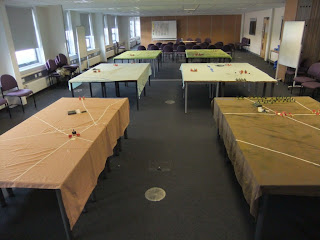The real map. Like the originals this was one of Michelin's finest. The six tables are marked out with highlighter pen. The line marking the northern edge of the playing area runs north of Fauqambergues, Bethune, Valenciennes, Beaumont. In the south, Amiens is the big urban area just off map 6, and the line then runs to the south of Montcornet and Berlise. Abbeville is just off to the west of the marked area.
The elite of the Wehrmacht listen attentively to General Von Munster's briefing.
The French commander was given eight infantry divisions and and assets including three tank battalions and some artillery and allowed to deploy them more or less as he pleased. Two armoured divisions and a motorised infantry division were on their way to reinforce. He was also told that the six aerodromes in his sector held considerable air assets.
The French team indulges in one of several musical interludes. At one point the
Germans offered to withdraw if only the French would stop singing!
The table setup. Three of us managed to rearrange the room and set up these tables in only 1 hour!
I reproduce below (with the kind permission of Jim Wallman) the briefing document issued by Von Munster to his Generals. Further down the page are the individual table maps.
German
Briefing
Objectives: Head for the coast, cutting off French 1st
Army and the BEF to the north. Do not
get distracted by chasing individual enemy units or besieging towns.
Command
Structure
Unit
|
Role
|
Player
|
Panzer
Gruppe West
|
Lt-General
Hermann Von Munster
|
Jim
Wallman
|
XIV
Corps
|
General
of Infantry Gustav Anton von Wietersheim
|
Jerry
Elsmore
|
Comprising:
|
||
11 Division
44 Division
72 Division
|
Lt General Herbert von Böckmann
|
Tom
Mouat
|
23 Pz Division
|
Major-General Hans Reichsfreiherr
von Boineburg-Lengsfeld
|
Trevor
Ringrose
|
XIX
Corps
|
General
of Cavalry Heinz Guderian
|
Phil
Steele
|
11 Pz Division
|
General der Panzertruppen Ludwig
Crüwell
|
Wayne
Thomas
|
7 Pz Division
|
Brigadier-general Erwin Rommel
|
Peter
Antill
|
2 Pz Division
|
Maj-General Rudolf Veiel
|
|
XXXI
Corps
|
Major-General
Georg-Hans Reinhardt
|
Fred
Cartwright
|
Comprising:
|
||
3 Mot. Division
|
Major-General Walter Lichel
|
Adrian
Hussey
|
14 Pz Division
|
Major-General Erick-Oskar Hansen
|
Harry
Kelly
|
8 Pz Division
|
Colonel Erich Brandenberger
|
John
Armatys
|
19 Pz Division
|
General der Panzertruppen Otto von
Knobelsdorff
|
Colin
Maby
|
Lufwaffe
Support : Luftflotte 2
Requests for air support are all via Panzer
Gruppe W HQ at all times. Maximum
concentration is to be used, so requests for ‘penny packet’ air support will be
automatically denied.
Lufwaffe
resources allocated to this operation are:
2 Fighter, 2 Zestorer, 3 Stuka, 1 Bomber and
1 recce squadrons
Communications: Commanders may only communicate with their
immediate superior or subordinates. All
communication will be in writing unless the unit HQs are co-located.
Morale
You represent the best the German Reich has
to offer and your Fatherland expects great things of you. This is the first battle against a modern and
well equipped major power and its allies and will be a true test of the new
German Army.
Medals will be issued to commanders who show
the highest energy and correct degree of offensive spirit.
Similarly, where performance does not reach
the highest standards of the Wehrmacht, the high command will be removing
underperforming officers to duties more in keeping with their abilities.
Doctrine
There is, as yet, no Army doctrine for
armoured warfare. Theorists are agreed
that massed armoured formations supported by air power are the weapon of the
future, but exactly how that will work in practice has not yet been pinned
down. Experience in Poland showed us
that our panzer divisions were prone to breakdowns and had serious logistical
problems, but the lack of an enemy with modern weapons meant that we could not
properly test war fighting doctrines.
Many of the logistical issues have now been resolved, but the principles
of modern tank warfare are still in their in their infancy. There is confidence at the highest level that concentrated massed tank offensives will
achieve a great victory. However,
military experience tells us that it also carries with it very great potential risks.
Each Corps is therefore able to develop the
tactics is feels will be most successful, subject to some overriding principles
– these principles are:
a.
Our primary mission is to reach the Channel,
not to necessarily destroy enemy units.
b. Speed of advance is
everything. We demonstrated
in Great War during the Kaiserschlacht Offensive in 1918 that bypassing strong
points and advancing rapidly throws the enemy into disarray.
c. We only have a few Panzer
Divisions.
There are no more coming if we lose these.
d. Our enemy is well equipped
and cunning. None
of us can forget the French Army’s ability to exploit weakness and
counterattack with ferocity as they did on the Marne in 1914. So - whilst we
are facing some of the weakest units of the French Army, we must not forget
that they have powerful reserves and might still ‘pull something out of the
bag.’
Once the campaign is successfully concluded,
we will be in a position to firm up our doctrine for Panzer Troops based on
your actions experience and successes.
Coming next - opening moves

.JPG)
.JPG)







6 comments:
For an airman's-eye view of the battle, see : http://notquitemechanised.wordpress.com/2013/08/18/megablitz-france-1940-part-1/
Wow epic in scale!
Chris Kemp
Thanks again for running the air side of things Chris.
Geordie
It's the only scale to tolerate!
Hermann Von Munster indeed!
Paul Foster
100% historically accurate as always!
Post a Comment